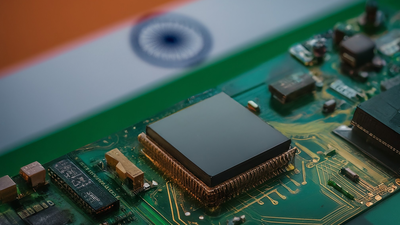The chip race: US opens tech gates for China; Should Indian companies worry?

This is an AI generated image, used only for representative purpose.
India must take steps to ramp up its domestic chip design capabilities as competition from China intensifies, experts have warned. The warning follows the US decision to lift restrictions on exports of Electronic Design Automation (EDA) software to Chinese firms.
Trump Secures China Trade Deal: Rare Earths To Flow, Students To Stay In U.S. | Watch
This reversal of curbs introduced under US President Donald Trump now allows major EDA companies, Cadence Design Systems (San Jose), Siemens EDA (Wilsonville), and Synopsys (Sunnyvale), to fully resume operations with Chinese entities.“The strengthening capabilities of China's industry could create increased competitive dynamics, not only for India's EDA sector but also across the wider electronics and semiconductor industry,” Ruchir Dixit, chairperson of the India Electronics & Semiconductor Association (IESA) board of directors told ET.He further added that “until a few months ago, nobody thought of software as a supply chain problem. Now, with this action, the supply chain includes software as well. It includes anything that enables creation and employment in India.” Asked if the move could lead firms to rethink their ‘China Plus One’ strategy, Dixit said companies evaluating India for EDA or related functions might now reassess the timing of their investments.
However, Shankar Krishnamoorthy, chief product development officer at Synopsys, noted that the company does not anticipate similar restrictions as China being placed on India, citing New Delhi’s growing semiconductor ambitions and its collaboration with the US.Still, the decision highlights the increasing competition, said Biswajeet Mahapatra, principal analyst at Forrester. He said that with renewed access to key design software, China’s chip industry could accelerate its R&D and manufacturing efforts, intensifying the global race for market share and foreign investment, particularly in design and packaging, where India is also making notable progress.Kunal Chaudhary, partner and co-leader of EY India’s Inbound Investment Group, stressed the need for urgency. “India must move faster on chip design. With the US easing EDA export restrictions for China, the global playing field is shifting,” he said.Chaudhary emphasised that developing India's own chip design software is a strategic necessity, not only to build resilience but also to lead the next wave of semiconductor innovation, urging targeted investment in R&D, intellectual property, and advanced skill development.Kathir Thandavarayan, partner at Deloitte India, said the removal of EDA software restrictions will allow Chinese design firms to push ahead with advanced chip design efforts, key to driving cutting-edge technologies like artificial intelligence (AI) and high-performance computing.India, he noted, is currently focused on mature nodes that meet 75–80% of global demand and aims to develop an end-to-end value chain in the medium term.
The country already accounts for 20% of the world’s semiconductor design engineers and plays a vital role in advanced node design.Jaswinder Ahuja, former managing director of Cadence India, said the immediate impact on Indian firms may be limited, but the decision “raises questions about potential future restrictions on India”. He also saw opportunities for startups in areas like AI, chiplets and 3D-IC packaging.
These startups, “unencumbered by legacy constraints, can reimagine design approaches and drive innovation,” he said.Dixit pointed out that none of the beneficiaries under the government’s Design-Linked Incentive (DLI) scheme are EDA companies. “They are all design companies, people who will make or design some silicon or some printed circuit board (PCB) that will go into a system using EDA,” he said, quoted by ET.He added that the dominance of major players such as Siemens, Cadence and Synopsys makes it difficult for smaller firms to find unsolved problems. “They don’t have enough people to solve a problem if it is a very complicated problem,” he said. He said this is why India has yet to see many EDA companies offering a broad range of products in the early stages.While the US move signals greater stability in global tech trade, experts agree it has created a more competitive environment for India. Experts say that India should use this period of stability to strengthen its domestic capabilities, make significant investments in R&D and skill development, and secure its place in the global semiconductor industry.
You may also like...
Diddy's Legal Troubles & Racketeering Trial

Music mogul Sean 'Diddy' Combs was acquitted of sex trafficking and racketeering charges but convicted on transportation...
Thomas Partey Faces Rape & Sexual Assault Charges

Former Arsenal midfielder Thomas Partey has been formally charged with multiple counts of rape and sexual assault by UK ...
Nigeria Universities Changes Admission Policies

JAMB has clarified its admission policies, rectifying a student's status, reiterating the necessity of its Central Admis...
Ghana's Economic Reforms & Gold Sector Initiatives

Ghana is undertaking a comprehensive economic overhaul with President John Dramani Mahama's 24-Hour Economy and Accelera...
WAFCON 2024 African Women's Football Tournament

The 2024 Women's Africa Cup of Nations opened with thrilling matches, seeing Nigeria's Super Falcons secure a dominant 3...
Emergence & Dynamics of Nigeria's ADC Coalition

A new opposition coalition, led by the African Democratic Congress (ADC), is emerging to challenge President Bola Ahmed ...
Demise of Olubadan of Ibadanland
Oba Owolabi Olakulehin, the 43rd Olubadan of Ibadanland, has died at 90, concluding a life of distinguished service in t...
Death of Nigerian Goalkeeping Legend Peter Rufai

Nigerian football mourns the death of legendary Super Eagles goalkeeper Peter Rufai, who passed away at 61. Known as 'Do...



